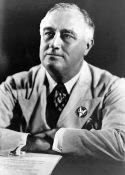"Malcolm X NYWTS 2a" by Ed Ford, World Telegram staff photographer - Library of Congress. New York World-Telegram & Sun Collection. http://hdl.loc.gov/loc.pnp/cph.3c15058. Licensed under Public Domain via Wikimedia Commons - http://commons.wikimedia.org/wiki/File:Malcolm_X_NYWTS_2a.jpg#/media/File:Malcolm_X_NYWTS_2a.jpg
Malcolm X was born on May 19, 1925. His birthday is celebrated as a holiday in Berkeley, California.
I attended the debate between Malcolm X and James Farmer at the Cornell University Law School on March 7, 1962, and later had a chance to talk with both Malcolm and Farmer at a small post-debate reception at Telluride House.
In the debate, James Farmer of the Congress of Racial Equality (CORE) and leader of the Freedom Rides of the previous year, argued for integration as the only moral and practical way forward for the country. Progress was slow, he conceded, but progress was happening.
Malcolm, who was at the time still a minister in the Nation of Islam, and who was accompanied by two bodyguards (and, unknown to us, apparently by FBI observers) argued for separation of the races on the grounds that integration was not working and that in any case American blacks wanted not "an integrated cup of coffee" but "freedom, justice, and equality."
A transcript of the debate was later published in a local newsletter; it has been reprinted in Ronald Reid and James Klumpp, American Public Discourse.
See:
Benson, Thomas W. "Rhetoric and Autobiography: The Case of Malcolm X." Quarterly Journal Of Speech 60, no. 1 (February 1974): 1-13.
Farmer, James. Lay Bare the Heart: An Autobiography of the Civil Rights Movement. Fort Worth: Texas Christian University Press, 1985.
Malcolm X. Autobiography of Malcolm X: As Told to Alex Haley. New York: Ballantine, reprint ed. 1992.
Reid, Ronald, and James Klumpp. American Rhetorical Discourse. Waveland, 1988, 1995, 2005.







.png)










.jpg)



















